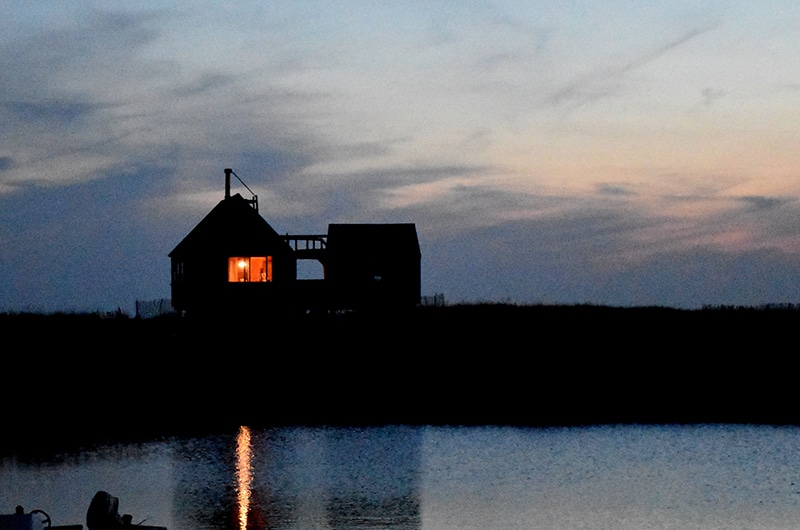by Robert P. Barsanti
My neighbors are selling their summer place for seven million dollars. The websites tell me that the mortgage on that will break down to a neat 29,000 dollars a month. The house has been improved over the last two years, down to the foundation. It now boasts nine-and-a-half foot ceilings, for the Christmas trees, seven baths, five bedrooms, and a pool in the backyard. Unfortunately, the view from the Upstairs Master Bedroom encompasses the swaying and aging grace of my homestead and its accompanying cars.
The realtors have begun to land. They circle around, with landscapers and a makeup brush, identifying that special something that will make the Hedge Funder drop seven million. They cluster together at the front porch, preening, and eyeing us across the street. I suspect they will put a note in the mailbox.
Winter arises from the island in a gray funk of clouds and cold, interrupted by wind, rain, and wet snowflakes. Once a week, the clouds will lighten, the air will warm, the roar of the surf will settle and a warm thought rises. Until the wind shifts back into the northeast, the sky starts spitting, and you roll the windows up to keep that warm thought from being sucked out to sea and drowned. Spring calls and tells you it is coming, and then the boats get cancelled. When the boats start up again, Spring lands and wants to see what work was done over the winter. The sky clears, the air warms, and the brown grass burns green. Within a day, buds dot the ends of branches, daffodils push green buds up through the ground, and crocuses surprise through the leaves and trash. Two days later, the clouds blow back in and everything that bloomed must survive.
But the fire is lit. Like the rain in the desert, everything blooms. The hedges bud, the swamps green up into marshes, and then yellow splashes in the fading gray both from the daffodils and the forsythia, and the grays of winter fade into the mud.
But not gone. Winter abides, in the shadows underneath the brush and hedges, in the gutters and in memory. It exists only for those who remember and survive.
This winter blew. It did things to the shore that winter never did to land before. The Atlantic came rising down bluffs of Sconset and scoured the bankers’ sand out and dropped it on the sand bars and shoals offshore. The harbor rose above the walls and piers, then overspread the downtown feet deep. Behind the Dreamland, two bicycles were locked, left in August, but not forgotten. They became our best barometer as successive storms brought ocean water up to the handlebars.
The water has slipped back to its reflective and photographic home in Easy Street Basin. The benches have been replaced, as have the bricks. The restaurants have been swept out, rewired, refitted, and staffed up for another summer of “Dark and Stormy” that lives in a copper mug. Further north, near the yacht club, the sewer lines have been repaired, the road resurfaced, and another brick sidewalk has been built for this summer.
The tide line from the once and future floods are scrubbed away in the energetic spring. We have swept away the sand, relaid the brick, and washed the buildings. By July, the island will look as it has always looked—as fresh as a Gin and Tonic. Nantucket, and its realtors, would like to live only in the immortal present of the beach.
Out here, I fear we measure time in real estate. The measure of this winter can be found in Madaket, where the stilt house succumbed to time, tide, and reality. In September, it rested atop a set of dunes and gazed on the Atlantic.
Then, the storms began chewing up the beach and overtopping the dunes. For several days, the Atlantic sprinted up the sound, then rolled down into Hither Creek. By March, the ocean washed under the stilt house with regularity, until the backhoes of time smashed it down and loaded it into a truck.
Now, the ocean has filled in that pond, buried the beach grass, and swamped an old pier that may have been built by Millie. Spring brings the denial of grass and the erasure of sand. The posts stand amid the ridiculous sand, becalmed and bedazzled by the change. Everyone who has a house beyond the bridge knows what is coming when the flowers fade and the storm clouds return.
Not today. Today, the wind has turned to the southwest, the sky glows, and the grass twitches. The golfers patrol the Miacomet fairways, the landscapers mow the bankers lawns, and everything is glowing green and yellow. That evening, I returned to the homestead. My neighbor’s house remained dark, but someone had cleaned the mud and sand from the pool. Two hoses were emptying into the fieldstone hole, under a watchful spotlight and a humming filter.
My duty, at the moment, involved the marsh behind my house and within the view of the upstairs master bedroom. Several branches of a Japanese Oak had fallen into my yard during the winter. Someone, who had boots and gray hair, needed to drag them out into the wetlands for natural recycling. I followed an old path among the bushes and puddles until I came to a line of daffodils.
They followed the three walls of a basement to a farm house that had been built out here when milk cows were the things you could bank on out on our island. The house had collapsed seventy-five years before I came here, the cellar filled in some time after that. Now, there was a row of cement one foot off the beach grass, lined with daffodils. Flowers out lived the yard, the house, the gardener, and would survive winter after winter after winter.

